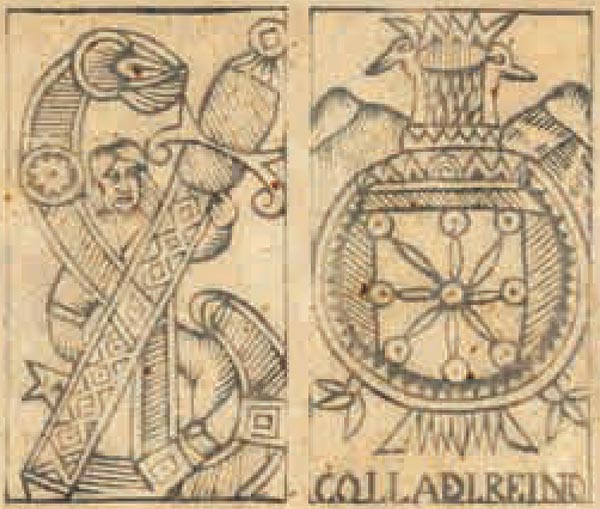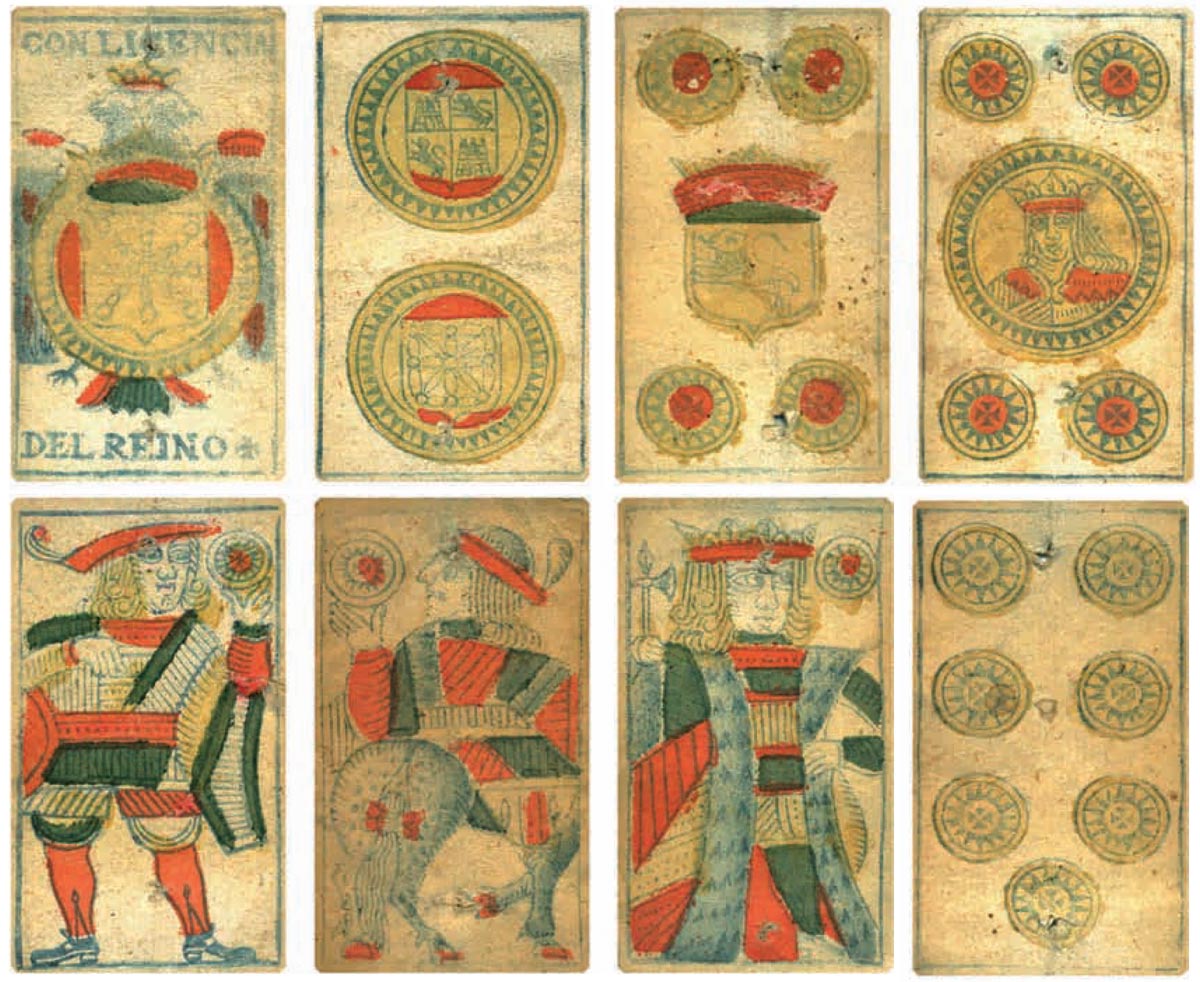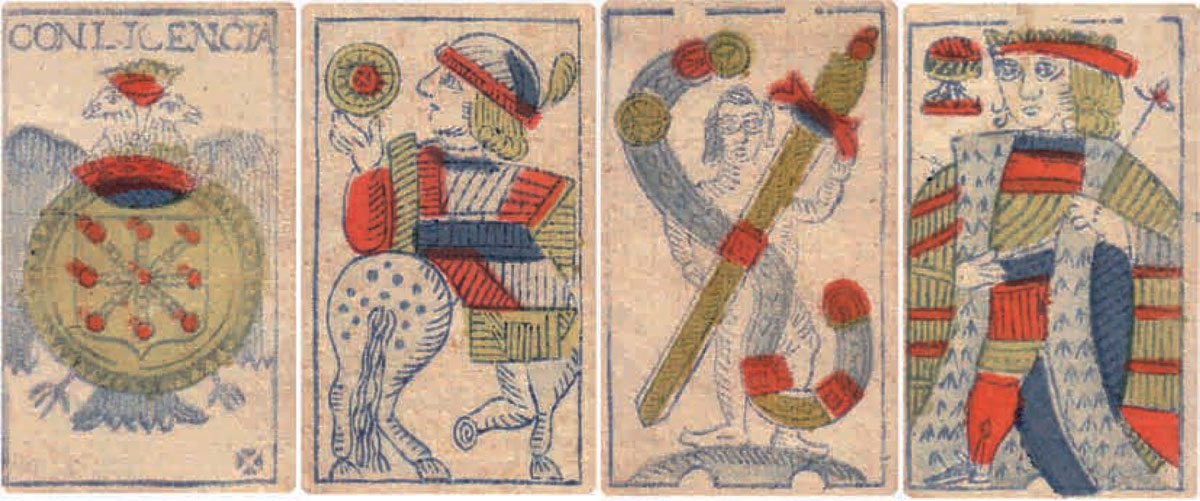Navarra Pattern
Navarra Pattern produced for the Pamplona General Hospital Monopoly.
Playing cards had been produced for the Pamplona General Hospital Monopoly in the former kingdom of Navarra since 1631. As the monopoly contract was repeatedly renewed over time, and in order that cards could be differentiated from those of neighbouring kingdoms or tax jurisdictions, the designs became established as a regional pattern.
It is likely that wooblocks, and even completed packs of cards, were originally produced in France, before being produced in Spain, which explains why the designs contain features common to earlier, archaic French-made cards. Problems with the quality, as well as illegal imports, were often cause for disputes with cardmakers at the time of renewal of their contracts.

Above: ace of coins featuring the coat of arms of Navarra with a double-headed eagle and the inscription CON L(A) L(ICENCI)A DEL REINO, anonymous manufacturer, 1682. see more →
PEDRO VARANGOT, 1786
It is recorded that Pedro Varangot was married to Jeanne Darretche in Bayonne in 1743. Earlier packs attributed to him were made in Bayonne. see more →

Above: Navarra Pattern produced for the Pamplona General Hospital Monopoly by Pedro Varangot in 1786. Woodblock and stencil coloured. From the collection of Martín Pedro Marcos González. see more →
Unknown Cardmaker with initials I. I., 1793

Above: Navarra pattern by an unknown cardmaker, produced at the Pamplona Hospital Monopoly factory, dated 1793. From the collection of Gonzaga Gil-Delgado Friginal. See more →
CREDITS & REFERENCES
Ferro Torrelles, Víctor: Unos Naipes para el Reino de Navarra, in “La Sota” Nº44, Asescoin, Madrid.
Additional research by Alberto Pérez González.

By Simon Wintle
Member since February 01, 1996
I am the founder of The World of Playing Cards (est. 1996), a website dedicated to the history, artistry and cultural significance of playing cards and tarot. Over the years I have researched various areas of the subject, acquired and traded collections and contributed as a committee member of the IPCS and graphics editor of The Playing-Card journal. Having lived in Chile, England, Wales, and now Spain, these experiences have shaped my work and passion for playing cards. Amongst my achievements is producing a limited-edition replica of a 17th-century English pack using woodblocks and stencils—a labour of love. Today, the World of Playing Cards is a global collaborative project, with my son Adam serving as the technical driving force behind its development. His innovative efforts have helped shape the site into the thriving hub it is today. You are warmly invited to become a contributor and share your enthusiasm.
Related Articles

French Revolutionary cards by Pinaut
Seven cards from a French Revolutionary pack by Pinaut featuring characters from classical antiquity...

Tarot de las Coscojas
Historical playing card design, tarot symbolism and an almost psychedelic medieval surrealism.

Tarot de Valverde de la Vera
A series of 24 surrealist engravings by Mexican artist Claudio Favier in which archetypal Tarot alle...

Baraja de Juan Martín Zamorano
Deck inspired by El Pendón de los Zamorano, a military pennant dating from 1501, published by Priego...

Heráldica Castanyer No. 16
Strange variant of international pattern cards for poker or bridge.

Fantasy Spanish-suited deck
Fantasy Spanish-suited deck by Bertschinger y Codina, Barcelona.

Trappola cards from Poland
Trappola cards published in Warsaw by J G Du Port during the 18th century.

Bertschinger y Codina - Cartes Françaises
French ‘Paris’ pattern made by Bertschinger y Codina, Barcelona, c.1850.

Braulio Fournier
Baraja Nº 1 produced by Braulio Fournier, Burgos, c.1868.

Pirritx eta Porrotx
Happy Families card game from the Spanish Basque Country.

Naipe Vizcaino
‘Naipe Vizcaino’ designed by Javier Urkiri and published by Industrias Gráficas Castuera and the Caj...

Baraja Turística del País Vasco
Basque poker deck of 55 cards published by Fournier with scenic views of the Basque Country.

Baraja Vasca
Spanish Basque Country deck with original drawings by María Isabel Ibañez de Sendadiano.

Baraja Cultura Española
ASESCOIN pack for 2022 designed by M.A. Corella featuring famous Spaniards and notable buildings.

Laurenzo Propagine
Spanish-suited cards made in Italy by Laurenzo Propagine.

Jeu de 7 familles Les Dynasties d’Artisans Basques
Long-standing Basque businesses represented in a traditional card game with illustrations by Odile A...
Most Popular
Our top articles from the past 28 days

